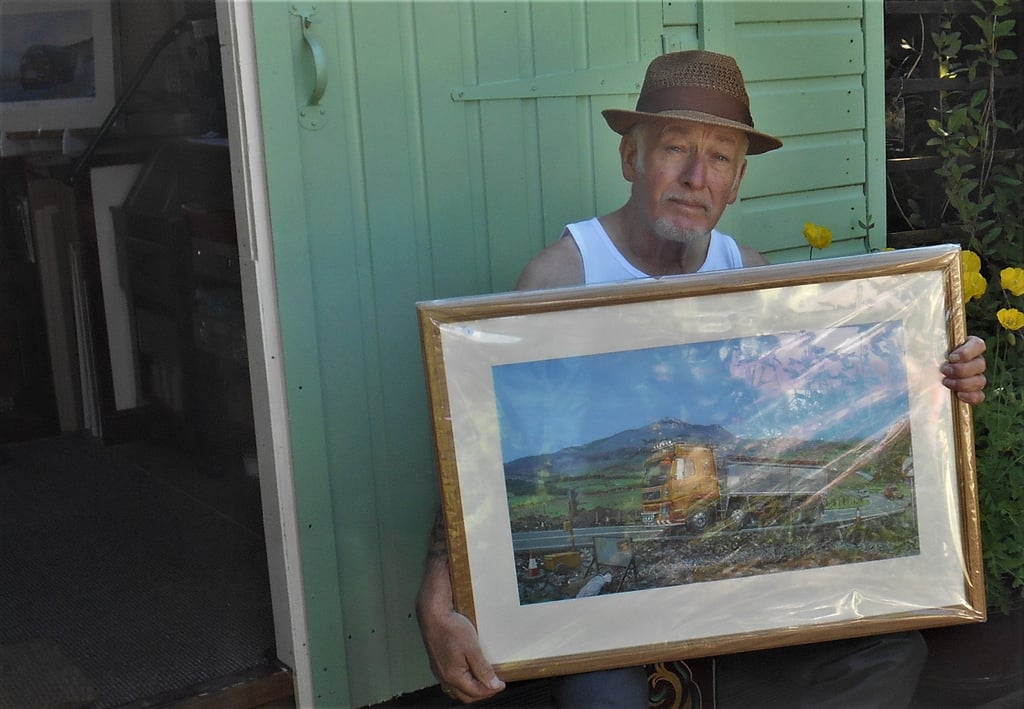Established 1984
I was an art student, turned long distance driver. A lonely life, with strangers for company, passers-by as friends, but Stars of the Road to guide you. After 20 years I went back to the painting - the one subject I knew. No Still-lifes or Nudes - but Lorries and Roads. Art galleries weren't interested, so our family took our own fixed display of originals around, Nationwide. No-one was doing this then. We travelled the show 22 years, until 2007, to Country Fairs, Transport Rallies and Venues. Starting from April and carrying on through to November we sold paintings, prints, cards and books. After November we’d deliver calendars. We found plenty of work and met some amazing folk. It was quite hard going most of the time - The charmed life always!

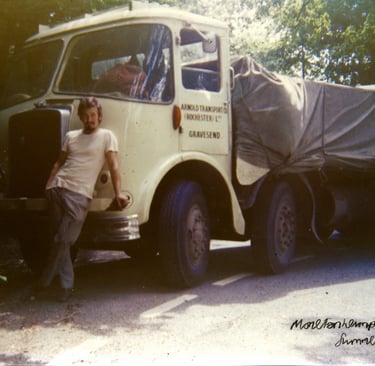


I packed up driving for a living after 20 years, early 1980s. I decided to try making a living from painting lorries instead of driving them. So, fast forward to 2016 when I’ve managed to make the living, with a bit more time on my hands I did a picture for Coll - of us on a similar trip we had, four drops – for Chard Junction, Moretonhampstead, Tavistock and Croyde Bay, but a more modern version. A bit fanciful you might say but the road and its memories won’t let me go. Loaded with plasterboards we were on our way to our third drop, down to a school at Tavistock needing a refurb. In the painting the lorry is a Hino 700 which I rate as a looker, a good working lorry, a bit like an Atki. - stylish but no frills!


When I was on the Long Distance, Colleen my wife sometimes came on trips with me, but not that often. The painting “Windwhistle”, below was made in 2013, using Flashe Vinyl paints, and matted behind glass, inside a Hemlock frame. It shows us two on one of those journeys. We are going by the fog bound Windwhistle Pub, late July, on the old A30 between Crewkerne and Chard, in Somerset. The road is no longer open to Lorries. We did a lot of work to the West of England, often along the A30 or A303. Rochester to Honiton was a day’s work. You knew all about it at the end of the day, especially in the summer! Four drops of Gyproc Plasterboard in Devon and Cornwall, plus return load, took all week. Harder work, slower pace.

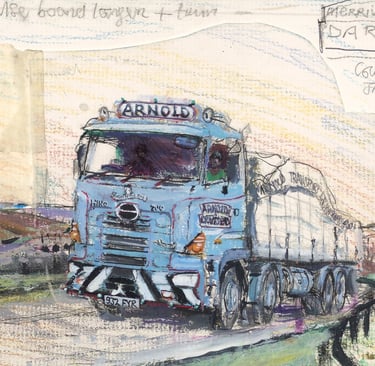
I used a more recent photo of Merrivale Bridge. The road there hasn’t changed much from the new by-pass days. Instead of the white Atkinson, a more modern (2010) light blue Hino 700 was put in. So, the Lorry colour is in my “Sunbeam Blue”. The Sky and Background colours follow the lorry’s livery, either to enhance it, or as a contrast to set it off. A few details to note for the lorry- it has the same fleet no. and reg. no. as the best one of the Atkinsons I drove there. An Atkinson style ribbon with the Knight of the Road Emblem on the front, some red lining out, Chevron bumper, New Zealand Style mirrors, and, well, it has to be ropes and sheets, of course! The Header board has the plain Arnold’s style Signwriting. Coll and me are in the cab, as we are nowadays, a couple of old fogeys!

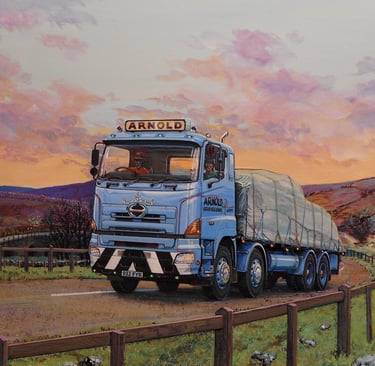
MERRIVALE BRIDGE DARTMOOR
Memories of 50 years ago- coming down to Merrivale Bridge, Dartmoor, not in a Hino, but an Atkinson. We’d delivered to Unigate at Chard Junction, and to MoretonHampstead. We were on our way to our next drop at Tavistock. I often wish we could do those few delivery trips we had together all over again. It’s not to be, so this is the only way to make it happen – a PAINTING! – but us two as we are today, and with a modern take on the old Atki.
"A Painting is the most beautiful of Lies" - Kees van Dongen Painter 1877-1968


In 1983/84 I painted a couple of dozen lorry and road scenes. We framed these ourselves and hawked them round to different art galleries. Who hadn’t a clue what the pics. were all about. And weren’t that interested anyway. One art dealer said – why not put a Gun dog sitting in the cab to bring it to life! -
I could see we were wasting our time, so Coll says – let’s make our own travelling picture show and by-pass the dealers and their galleries -
As for the rest of the Roadscapes pictures - scenes of the road from far and wide – I was painting these to order, for a living, from 1984 till 2024 - but the very first lorry pic. was made in about 1960 of an AEC. The title was - “Night Trunker”
All to try and get some work. We called it "ROADSCAPES - scenes of the road." Which it has been ever since. To use my own name seems a bit over the top, so I try to stay incognito. Just alan/roadscapes will do. Fly low, fly long sort of thing. I don’t want to be anybody special. I don't think there was such a thing as ROADSCAPES before then, or anyone else doing road haulage paintings for a full time living, or anyone who travelled a show round to get the work, for that matter! I never saw them anyway, apart from Keith Hudson on the Fairground stuff. I would just say that Peter Davies from Bedford is the most knowledgeable Lorry Artist, but he’s never made it his full time living, which has been from Photography and Writing. There’s several others too, like Technician Malcolm Root, but really, I hope I’m right in saying, he specializes in Railway Paintings. A damned good Traditional painter though - which I am not!
After I’d got enough pictures together our first rally was in May 1985. We went to local country shows to start with. We had a bit of interest here and there that Summer, but not much. I was all ready to give up but in the Autumn we tried for one last ditch attempt, to a bit further afield. We went to the Dorset Steam Rally, followed by the Leyland Lancashire Autumn Rally, and that’s where it really took off!
We travelled the show all over the UK, each weekend, March till October at first, then after a few years narrowed it down to about half a dozen really good shows where we always got work - 1000s of miles until 2007. Mostly to the North, where the interest was. Orders for paintings of Waggons came flying in. Sometimes you'd be lucky enough to get a photo to go on, usually black and white from the wrong angle! More often than not just a description, with no photo. But 20 years on the road stood me in good stead. I knew Roads and the history inside out, more or less - where the trunk roads, side roads, short cuts, went - which lorries would travel where - what sort of Loads - Ropes and Sheets - long gone Transport Cafes - Landmarks – etc. I didn’t want to do “Streetscapes” so much, because when you are on the Long Distance you are watching the miles go by, not sitting below some Town Hall clock! It’s beautiful landscapes, stunning Skies, in all weathers, all year round, by night and by day - all the way! I had the added bonus of learning the Trade/Craft of the Haulage Driver, taught by people who believed in the patience and care to do a job properly.
So, as for the work – well, I did my very best and never cut corners. We never stitched anyone up, following the Benedictine Monks principle (I think so, anyway?) of aiming for good, honest, affordable work, using good top-quality paints and materials. It was a hard way to make a living but a real pleasure to do. Often working with 30 - 40 commissions ahead, which we’d deliver on trips, or at rallies. I always said to folk - As long as you can bear with me for time- And everyone did. That in turn led to more orders - so I was always the Jobbing Painter. No Mega Bucks. No Merchant King's. The pay cheque was the Fantastic people you met, mostly Drivers, Transport folk and their families, one or two Artists, Art Teachers and Students who gave me the thumbs up, which certainly was a booster, and made me feel maybe I was doing the right thing after all. The customers often became life-long friends. The bit I remember most, and often smile about it, was the difference between the disgusted elderly lady at a Stourpaine Dorset Steam Fair, saying – Paintings of Lorries, whatever next! – she almost spat that out at me, and another group of elderly ladies at Leyland the following week, studying the pics. carefully with - That one had the Gardner engine, and that one was on a night trunk to London –
It was all commissioned artwork, mainly of British scenes, approx. 1100 in all painted, up to 2024, including those from pre-1984. We had a very big following in Scotland. Lovely colourful liveries, with Tartans and Thistles and all of that, but full-on, non-stop hard work, with a lot of 7- day weeks thrown in. I paced myself, never taking on time schedules, and avoiding the very big companies who were very slow payers, run by accountants rather than Transport people.
The shows we went to became our family holidays. Our kids saw a bit of the country all right and still to this day remember the trips fondly.
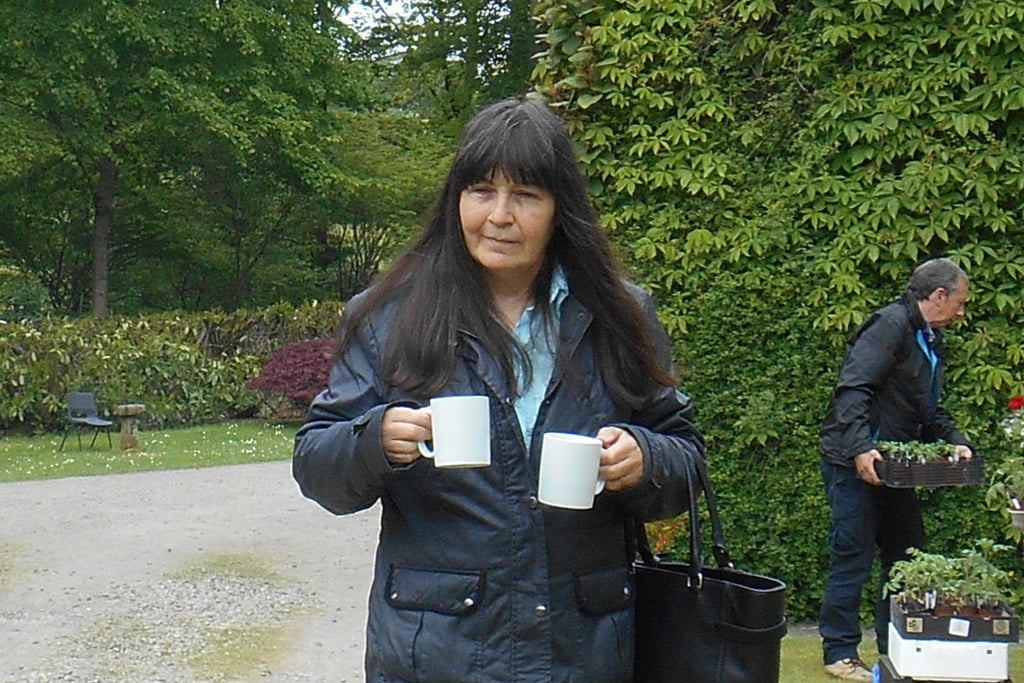

“English Road A74” Mean Ge-reen Maudslay Meritor Machine, from D.M.Smith, of Wishaw. “O” type Bedford following. Heading South on what the Scotsmen used to call the English Road.


“Paddy’s Milestone” Ostwald’s of Ayr AEC on the A77, near Girvan.


“A Dream on 6 wheels” Scottish Albion from J G Barrack, Aberdeen. Near Otterburn.




The final lorry painting was “Y Cymro”/ “The Welshman”. Painted in 2023-4 of an O.J.Jones Renault, 8-wheeled Tipper, from Porthmadog North Wales, set at Dolwyddelan, A470, with the Castle in the background. Class Cruiser or what!


ROADSCAPES - for the future
“High Voltage” – This is a was a plan which is really a semi abstract painting. Made back in 2000. It’s of an 8 wheeled Scania mixer lorry, set in the West of Ireland, on a stormy night. At one point, while I painted it, a Johnny and the Hurricanes record was playing, called - High Voltage- hence the name, which I thought fitted the bill. The titles to me are very important. Part of the Picture.
Another painting, a Foden cab interior, which I thought was finished - “Day’s End” - is needing a slight alteration. I’ll tell you about it one of the days. I’d like to try another Dee Valley Transport lorry picture – maybe of their Chinese Six (Twin Steer) Foden, that was called “Llewelyn”. Or a re-vamp of the “Maid of Llangollen”, but semi abstract style.
Have also gone back to doing a few more of our own Calendars. Not every year though. Roses Calendars at Colchester also use some Roadscapes.
And our son Olly is keeping this website going, as and when he can.
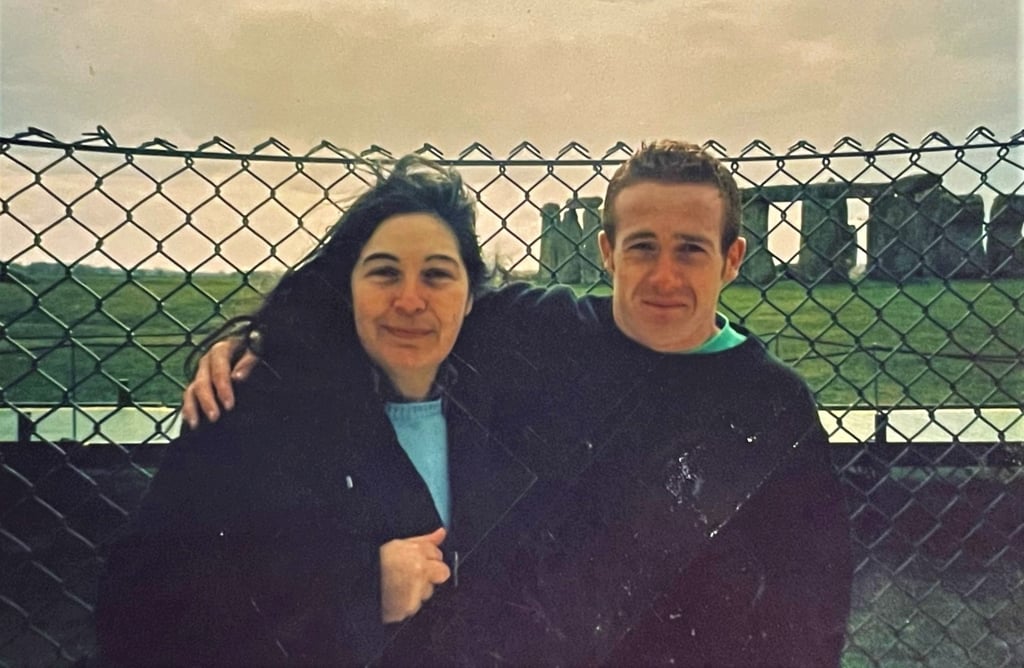

Olly and Coll at Stonehenge


One on the go right now - not a Lorry painting, but definitely a Roadscape – I recognise it! “Roundabouts and Swings”. An illustration for a poem written in 1912, of a Travelling Showman who is on his way to another Fair. He meets a roadside Traveller who asks him how things are doing. He answers – What’s lost upon the Roundabouts we pulls up on the Swings - It was in a book of poems from the1920s, with illustrations for some of them by Harry Clarke (1889-1931), the Dublin Stain Glass artist, the most fantastic Colourist, Technician, Artist I’ve ever seen, anyway. He didn’t do one for this poem. Maybe not quite up his street. But it’s right up mine. It won’t be anywhere near as good as his work, I don’t suppose. But we can give it a go. A bit of a challenge, what with all the Decoration and Detailing. It will take a couple of hundred hours at the least, so not one to be selling! One for the Family. Fingers X-ed I can do it!
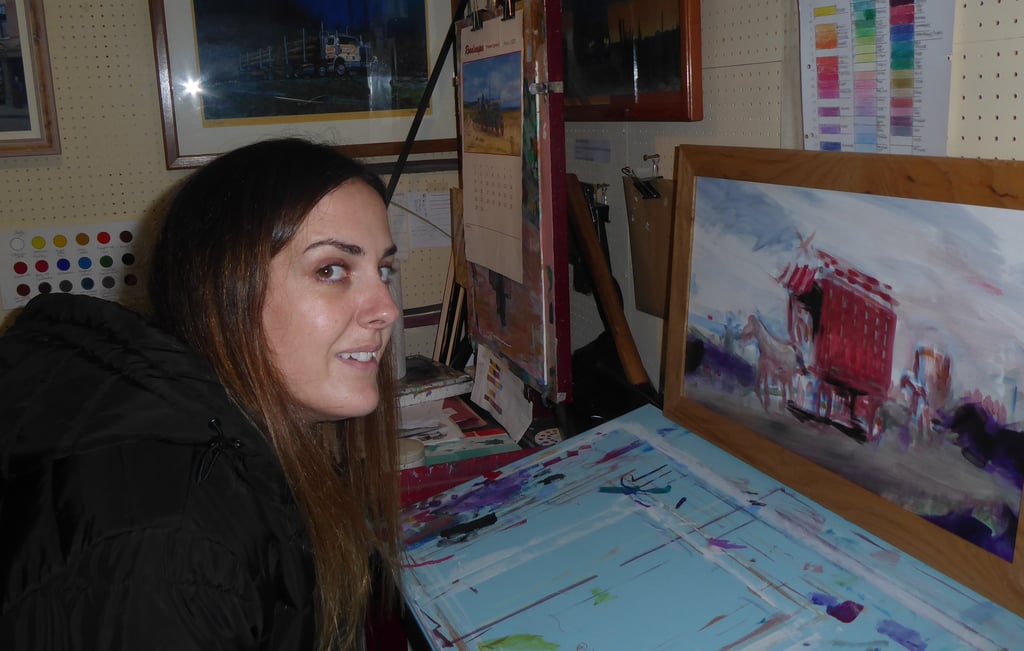

Picture of Ray, our darling Daughter and main Art Critic, with the painting started and on its way. She’s giving me the evil eye that says- M.A.N. (more alterations necessary) !
Check the Paintings gallery - with ongoing changes, and some pictures from way back, when we only managed to get a few of them photographed. Like “Ffordd Yr Arfordir”/ Coastal Road. Painted in 1989. Most of the gallery pics. are more recent, from about 2000, when they all started going onto disc.
Maybe if I can arrange another 40 years doing all this sort of thing, plus a bit of Picture Framing for Pals, it will keep me going .. I'll be 120 then! … will try and keep you posted ! !
